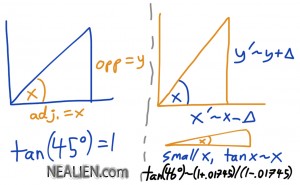Came up with a bit of a strange method for an approximation of tan(46 degrees)
I would first note that 46 degrees is close to 45 degrees.
The tan(45 degrees) = 1 since it’s a 45 degree triangle and the opposite over the adjacent is going to give you 1.
46 degrees is slightly above 45 degrees, so the opposite side is going to be a bit bigger than the adjacent side.
Therefore it will be a bit over 1.
From there I’ll think about how much different it will be than tangent of 45 degrees.
Since you’re given that 1 degree 0.01745 radians,
I think about the opposite side getting a bit bigger and the adjacent side of the triangle (for the 46 degree right triangle) getting a bit smaller (equal amounts).
I call the change ∆. If we call the opposite y and the adjacent x, then the slightly changed sides would change by this amount ∆. And because tanx ~ x for small angles, I’m thinking about the change in the angle 46-45 = 1 degree as the angle, which is fairly small.
So for an approximation, something that I came up with that seems to work…..
tan(46 degrees) ~ (1+0.01745)/ (1-0.01745)
= 1.035519821
If I just type in tan(46 degrees), I get
=1.035530314
If I use more accuracy in the calculator for the radian equivalent of 1 degree, I get
tan(46)~ 1.035526642
Which is different by 3.67188 x 10^-6
This method seems to work even for larger changes in angle. For example
tan(50) ~ (1+0.01745*5)/ (1-0.01745*5)
= 1.191180498
On the calculator
tan(50) = 1.191753….
So a bit less accurate, but still accurate to the nearest hundredth.
Not quite sure why this works.



Leave a Reply